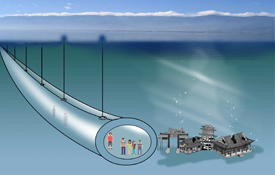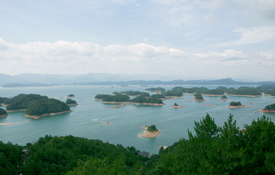|
 |
 |
|
(LI SHIGONG) |
QIANDAO LAKE: Appearing as islands, these were once the tops of hills in an area flooded after construction of a hydroelectirc station in 1959 (CFP) |
Two ancient cities lying at the bottom of Qiandao Lake were unveiled, enthralling the nation with their mystery and beauty.
From April 27 to May 1, China Central Television and Zhejiang Satellite Television jointly telecast an underwater exploration of the two cities. With reporters on site and an unmanned helicopter filming over the lake, the two television stations presented a three-dimensional view of the two cities to spectators across the country.
Beneath the serene water of Qiandao Lake (a lake with a thousand islands) lie the two ancient sites—Shicheng City and Hecheng City—a discovery that has since captured the imagination of observers.
Qiandao Lake, a gigantic man-made lake in Chun'an County of east China's Zhejiang Province, is hailed as "the most beautiful waters under heaven." It is home to 1,078 large islands and several thousand smaller ones scattering across it. The lake is a popular destination for people seeking a scenic spot.
Both cities have a history of more than a thousand years. Hecheng was built in 208 and the Shicheng was built in the current location in 621. Shicheng, the administrative center of the ancient Sui'an County, had many historic and scenic locales.
"We found a lot of memorial arches, stone doors and stone lions. These stone structures were kept intact underwater," said Zhang Shuheng, a senior research fellow with the Zhejiang Provincial Institute of Cultural Relics and Archaeology. "This is the most rewarding discovery since underwater exploration of the two cities was conducted in 2001," he added.
In a recent two-day excavation, the team explored Ruxueqian, the cultural and education center of Shicheng. An underwater robot found millstones, walls, large square stones and a number of construction relics.
Their findings match known statistics about the city. According to historical records, there was a Confucian temple, a school, six memorial arches and an ancient cypress in the area. It once cultivated 84 successful candidates in the highest imperial examinations and 203 in the imperial examinations at the provincial level. It served as a symbol of the profound culture of the city.
Mysteries remain beneath the surface, yet to be discovered. Local resident Zhang Weizhao described one missing piece, "In 1959, there was an ancient bell dating from the Yuan Dynasty (1271-1368) on the north gate tower of Shicheng. It weighed 1,500 kg. During the War of Resistance Against Japan (1937-45), people rang the bell to warn the local residents of invading Japanese. This was recorded in detail in the county annals. But unfortunately the divers went down several times but still couldn't find the bell."
Born in the 1960s, Zhang was one of the staff working on the live telecast. Although he didn't personally witness Shicheng, a vivid picture of the city was carved in his mind by the stories his parents told him of its past.
It was a typical ancient city. With convenient land and water transportation, the city had five gates, each of which had a gate tower. Around the city walls were eight watchtowers. Historic and scenic spots stood within the walled compound, including pagodas built in the Ming Dynasty (1368-1644) and the Qing Dynasty (1644-1911), memorial arches, ancient bridges and ancient tombs.
Qiandao Lake is actually a reservoir. More than 50 years ago, it contained dense woods and vast valleys, with the Xin'an River running through it.
In 1959, the then-largest water control project—the Xin'an River Hydro-Electric Power Station—began construction to supply power to its six surrounding provinces in east China, facilitating irrigation and preventing floods.
On September 21, 1959, the power station started to dam the river and store water. As a result, more than 290,000 local residents were resettled. Within half a year, the reservoir area flooded the two ancient cities, three towns and 1,377 ancient villages.
The first underwater exploration of flooded ancient cities took place in 2001, when the Beijing Dragon Diving Club Ltd., began a diving project at one of the lake's islands. Qiu Feng, an official of the local tourism administration, met them and asked the club to send divers to search for the remains of the underwater ruins.
On September 18, 2001, the exploration team began the first of many dives. "We were so lucky that the divers found the city walls and picked up a brick of it as soon as they went down," said Qiu.
| 